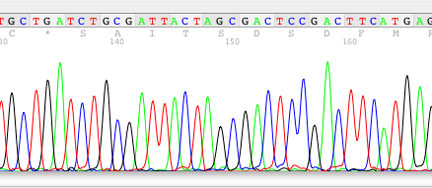![]()
Application of the Polymerase Chain Reaction (PCR)
and Bioinformatics in Bacterial Identification
Harriet S. Wilson
Professor of Microbiology, Biological Sciences Department, Sierra College
Abstract
Students in microbiology classes are frequently unable to identify bacterial isolates using traditional laboratory methods including observation of colonies, microscopic examination of stained materials and analysis of phenotypic characteristics. In this study various methods for extracting DNA from live bacterial cultures were explored, and the Polymerase Chain Reaction was used to amplify a portion of 16S ribosomal DNA approximately 1500bp in length from 25 different types of bacteria commonly encountered in a non-clinical laboratory setting. Different methods and materials for concentrating and purifying DNA samples were investigated, and segments of DNA between 500 and 800bp from 14 different types of bacteria were sequenced. Nucleotide sequences were compared to data recorded in the public database of NCBI using the BLAST algorithm and sequence homologies were determined. Of the 14 samples sequenced, five showed 100% homology with previously identified bacterial strains and one was found to be 100% homologous with an Antarctic bacterium of unknown identity. Six of the remaining isolates were 99% homologous with previously identified strains, one was 98% homologous and one 97% homologous. Samples showing low homology were suspected of being from mixed cultures. Application of the PCR, nucleotide sequencing and bioinformatics was found to be effective addition to traditional methods of bacterial identification in undergraduate microbiology laboratories.
Application of the Polymerase Chain Reaction (PCR)
and Bioinformatics in Bacterial Identification
(a PDF download link to the entire article - 3.7 MB)

In the near future, additional information will be added as refinements to the laboratory protocol(s) are developed, including information on "pit-falls" and other procedures that failed to work.
Additional Web URLs links related to this project
Contact Information for Harriet Wilson: hwilson@sierracollege.edu
Sierra College Microbiology Program - Biological Sciences Department
Copyright 2004 Sierra College Biological Sciences Department
Last updated: 07/07/04.
![]()
![]()